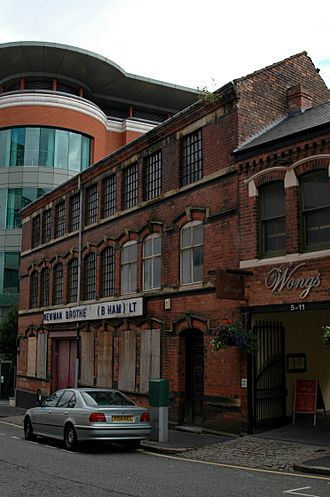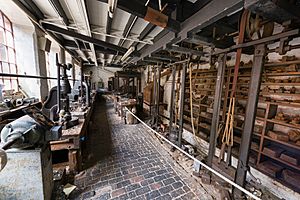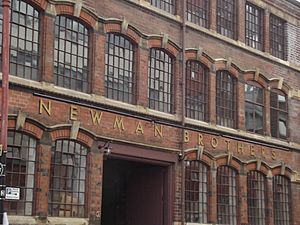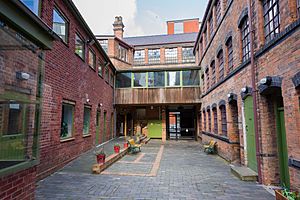Newman Brothers Coffin Furniture Factory facts for kids
Quick facts for kids Newman Brothers Coffin Furniture Factory |
|
|---|---|

The Newman Brothers factory viewed from Fleet Street in 2008, prior to renovation
|
|
| General information | |
| Type | Factory |
| Location | 13–15 Fleet Street, Birmingham, England |
| Coordinates | 52°28′55″N 1°54′27″W / 52.48194°N 1.90750°W |
| Construction started | 1892 |
| Completed | 1894 |
| Technical details | |
| Floor count | 3 |
| Design and construction | |
| Architect | Roger Harley |
| Awards and prizes | Grade II* listed |
The Newman Brothers at The Coffin Works is a cool museum in Birmingham, England. It's inside the old Newman Brothers Coffin Furniture Factory building. This factory made special metal parts for coffins. It was open from 1894 until 1998.
The museum teaches visitors about the factory's history. It also shows what life was like for the people who worked there. The museum opened in October 2014. This happened after a long effort by the Birmingham Conservation Trust. They worked for fifteen years to save the building. They also raised money to turn it into a fun place to visit. The building is at 13–15 Fleet Street and is a special Grade II* listed building. This means it's very important and protected.
Contents
The Factory's Story
How It Started
Newman Brothers began in 1882. Two brothers, Alfred and Edwin Newman, started it. They made things from brass. In 1894, the company moved to a new factory. This factory was at 13–15 Fleet Street in Birmingham. An architect named Roger Harley designed it in 1892.
When they moved, Newman Brothers changed what they made. They became a 'Coffin Furniture Manufacturer'. This meant they made brass parts for coffins. These parts included handles, crosses, nameplates, and decorations. They also made 'soft goods' like shrouds and coffin linings. Making these items used similar skills to their old brass work. The funeral business also offered more chances to make money.
Who Ran the Business
Edwin Newman stopped working in the business in 1895. Alfred Newman then ran it alone until he passed away in 1933. His two sons, George and Horace, took over. They ran the company until they passed away in 1944 and 1952.
After Horace's death, the Newman family no longer directly managed the factory. However, Horace's sister Nina still owned parts of the company until 1980. Other families, the Doggarts and Whittingtons, helped run the business.
Joyce Green became the last owner of Newman Brothers. She bought the company in 1976. Joyce had worked there for over 50 years. She started as a secretary in 1949. She worked her way up and bought the company in 1989. She was the only owner until the factory closed in 1998.
Famous Funerals and Global Reach
For many years, the factory made some of the best coffin parts in the world. These were used in very important funerals. For example, they were used for leaders like Sir Winston Churchill and Joseph Chamberlain. They were also used for members of the royal family. This included George V, George VI, the Queen Mother, and Princess Diana.
In the 1950s and 1960s, the company was very busy. About 100 people worked there. They sent their products all over the world. This included places like West Africa, India, Sri Lanka, South Africa, the Caribbean, Canada, and Malta.
The 1960s were a great time for the company. They had more money to make the factory better. An old part of the factory was taken down. A new two-story brick building was put up. This new building had offices, places for metal plating, and storage areas.
Why the Factory Closed
The company's success did not last forever. By the 1970s, things started to get harder for the business. One big reason was that metal coffin parts became less popular. More people in the UK chose cremation. New rules in the 1960s said that metal parts could not be used in cremations.
Also, plastic parts became common. These were made using a process called injection moulding. Newman Brothers did make some plastic handles and decorations. But they mostly wanted to keep making very high-quality metal items. They did not want to change their old ways of making things.
The company kept making high-quality brass coffin parts. But they struggled to keep up with new trends. In 1998, they had to close down. At that time, they were one of only three companies still making coffin parts in the UK. The company officially closed the next year.
Saving the Factory
The Plan to Save It
After the factory closed in the 1990s, Joyce Green fought to save it. She wanted it to become a museum. She did not want the building to be torn down. She also wanted the factory's history to be remembered.
In 2000, the factory was given a special status. It became a Grade II* listed building by English Heritage. This meant it was very important and needed to be protected. In 2001, the Birmingham Conservation Trust looked at the building. They worried it might be redeveloped and lost. So, they asked Advantage West Midlands for help. This group bought the building in 2003. They also agreed to help the Trust turn the building into a museum.
Challenges and Success
In 2003, the factory was featured on a TV show called Restoration on the BBC. It didn't win, but many people became interested in the project. After the TV show, things slowed down. There was some uncertainty about money. A plan for the business couldn't be made until 2005.
But in 2006, a large grant of £1.5 million helped get the project back on track. The Birmingham Conservation Trust then hired a team of experts in 2007.
There was another problem in 2009. Advantage West Midlands, the group that bought the building, lost its funding. They could not give any more money to the project. But the Birmingham City Council gave a grant. This allowed the Trust to buy the building in 2010. Even though the project costs had to be cut in half, it kept going. A new plan was made. An extra £1 million from the Heritage Lottery Fund helped the Trust move forward.
Bringing the Factory Back to Life
The work to fix up the factory happened between July 2013 and September 2014. It cost £3.4 million in total. Building companies and architects worked hard for a year. They turned the old, partly broken building into a visitor attraction. They also made some parts into office spaces.
The goal was to keep as much of the factory's original look as possible. The old 19th-century building was not changed. It was repaired where needed. The old roof was replaced with new Welsh slates. Plastic gutters were replaced with old-style cast iron ones. A modern sign was taken down. A Victorian-style sign was put up instead.
Three main rooms were restored for the museum. These were the "stamp room," where metal decorations were made. The "shroud room" was where coffin linings were sewn. The warehouse was where goods were packed and stored. The factory's 1960s offices were also fixed up. The impressive courtyard and gated entrance were also restored.
The museum opened to the public in October 2014. Joyce Green, who fought to save the factory, was involved until she passed away in 2009.
Newman Brothers Museum
The Newman Brothers Museum offers guided tours. Visitors can explore the restored factory. They learn about the company's history. They also hear personal stories from people who worked there. The building also has office spaces for small local businesses.





